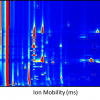Antony Neil Daviesa and Jörg Ingo Baumbachb
aExternal Professor, University of Glamorgan, UK. Director, ALIS Ltd, and ALIS GmbH–Analytical Laboratory Informatics Solutions
bISAS–Institute for Analytical Sciences, Metabolomics Department, Bunsen-Kirchhoff-Str. 11, 44139 Dortmund, Germany
Background
Back in 1999 we looked at the analysis of complex data sets in the field of Ion Mobility Spectrometry (IMS). These were no classical multi-dimensional files such as you would find in time-elapsed spectroscopy or multi-dimensional Nuclear Magnetic Resonance Spectrometry—why? Well for one the intensities in the various dimensions can actually affect the signals observed in the other dimensions.
This is due to the competitive nature of the signal generation in IMS. Also the most intense signal often observed has no real direct value in the normal data analysis—rather like the Rayleigh scattering in a Raman spectrum. As the signals often come from multiply-ionised clusters they may repeat at different times in the spectrum but as the shape of the cluster also plays a role in the drift time they may well not be simple multiples of the charge carried as you would find in, for example, Mass Spectrometry of proteins or other very large molecules. Finally, the process of generating the charge-carrying species also changes with ionisation source and a large number of other experimental parameters highlighted in 2006.
So one of the first steps in understanding the complex signals observed has been to run a high-resolution laboratory-based experiment in parallel and compare the measurements with reference data. In this case the multi-capillary column used for the preliminary species separation is used as a pre-column for a standard GC/MS.




